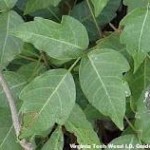Not having fun with Poison Ivy
 The bane of the Summer Camp councilor, the fear of every hiker, the worry of the adventurous child’s parents, the dreaded Poison Ivy. Found all across the United States with a few exceptions in the far west, Poison Ivy can readily be found most anywhere not of desert climate or high altitude. Able to grow vertically by climbing trees, or crawling across the floor of a pine forest, folks with a fondness for the great outdoors must be vigilant in their look out for this three leafed beast.
The bane of the Summer Camp councilor, the fear of every hiker, the worry of the adventurous child’s parents, the dreaded Poison Ivy. Found all across the United States with a few exceptions in the far west, Poison Ivy can readily be found most anywhere not of desert climate or high altitude. Able to grow vertically by climbing trees, or crawling across the floor of a pine forest, folks with a fondness for the great outdoors must be vigilant in their look out for this three leafed beast.
Poison Ivy can be found growing at the edges of any type of field within its range; edges of the forest, sides of the road, and environments that were razed to make way for shopping malls and new home divisions. For the hiker and camper a cautious eye must be kept along trails, lakes, ponds, open fields, and beaches.
The leaves of the plant itself are not the perpetrators that cause rashes and blisters. The actual antagonist is an oil secreted by the plant called Urushiol, (you-ROO-shee-all). This oil can be found not only on the leaves of the Poison Ivy, but on the stems and the root system as well.
The skin will absorb the oil within ten to sixty minutes after contact. Up to eighty percent of people will have an allergic reaction to the chemicals in urushiol, though many will not have a rash after their first exposure. Allergic sensitivity to the oil is known to be genetic, so parents who are identified to have more severe reactions should take extra precautions for their young ones. Inhalation of the air borne particles from the burning of Poison Ivy and the oil can cause damage to the respiratory system and may require immediate medical attention.
An unfortunate encounter with this fiend may result in only slight exposure and a few small irritated spots, the itching feeling growing worse over time, or you may be covered from head to toes with massive red rashes, sores, and blisters. From best case scenario to worst, contact with urushiol will most often result in some degree of discomfort. Often seen are the signs of exposure to the face, with swollen eyes and over puffy cheeks, bright red rashes, and a look of extreme unhappiness hidden underneath. While there are a variety of over the counter and home made remedies, the final verdict is still out on whether any of these actually help reduce the length of time symptoms will persist. Truly, your best bet is to successfully avoid contact at all costs.
It is not always easy to spot the three leaves of the Poison Ivy plant. The inexperienced and the young are most at risk of accidental exposure, so they should be taught how to spot and avoid the plant. Remembering the phrase, “If three leaves there be, avoid it shall yee,” can be a helpful reminder, but there are quite a few plants out there that boast leaves with little difference in appearance from the Poison Ivy. Using images of the plant or finding a real life example to let your children carefully view is a great way to become familiar with the general look of the plant. In the spring while the leaves are young they will be a nice bright red, fading to a dull green in the summer while new leaves of that season will be shiny and still a bit reddish. In the fall the leaves will blend with the rest of the colors of autumn in yellows, reds, and orange. During the winter, the Poison Ivy plant may have shed its leaves, but the twigs and shrubbery left behind can still have potent urushiol oil on them. Caution should be taken at any time of the year.
